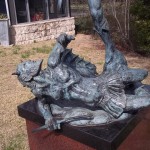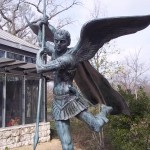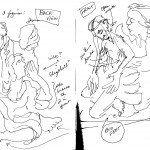Clash of the Titans The tradition of classical figure drawing at the Art Institute of Chicago was never more prevalent than when Charles Umlauf, Austin’s premier sculptor, arrived for classes in the nineteen thirties. Dogma became religion for much of the faculty, imposing such rigorous influence that the disciple-like student body protested with near-riot fervor against the iconoclastic modernism of the infamous NYC Armory Show, exhibited in Chicago in 1913. The modern human figure, as depicted by the likes of Brancusi, Picasso, Duchamp, and Matisse, was found to be devoid of classical proportion, not to mention social integrity, therefore was condemned by the parochial drawing students of the Art Institute of Chicago. Charles Umlauf’s love of mimetic representations of the classical human figure (as defined in the Renaissance) was molded and cast during his diligent years of study at the Institute. Umlauf brought this mind-set with him when he came to Texas in 1941, accepting the offer of Professorship at UT, in the newly expanding art department. UT’s long-standing commitment to the human figure as the most essential subject of drawing instruction is evidence of Umlauf’s lasting, classical influence. The former Abilene Christian College art major, Charlie T. Williams, served in Paris from 1944 to 1946, as a Corp of Engineer draftsman. In addition to becoming good friends with famed Harry MacElhone (Harry’s New York Bar), Williams attended gallery events and viewed the works of the most famous European artists of the day, including Mondrian and Miro, the Constructivists, Surrealists, and Expressionists, to name but a few of the influences he encountered. The young Texas artist also witnessed a bourgeoning array of mature art by many of the surviving artists whose work was originally introduced to America in the Armory Show of 1912 (NYC) and 1913 (Chicago). Williams was probably unaware of Allied, cash-limited efforts to restore the cultural heritage of Europe’s art and architecture, dismantled and destroyed under Nazi Germany, as heartily depicted in George Clooney’s recent “Monuments Men.” But Williams was acutely aware of his good luck to land in the middle of what was arguably the greatest modern art city in the world. The young West Texas artist entered Europe on Utah Beach. He marched straight into modern art in the first official dress parade of the U.S. and Allied Liberation of Paris. A red-cheeked, tearful young woman was so happy that she rushed to follow Williams into a public pissoir, showering him with kisses as he tried to relieve himself. Williams embraced modern experience the rest of his life. The brain-child of curator Katie Robinson Edwards, C2 Sculptors: Charles Umlauf & Chas. T. Williams united and juxtaposed the works of these treasured Texas artists in the most unique and informative sculpture exhibit of recent memory. Her academic interests in Umlauf’s own historical relevance, and her personal enthusiasm and appreciation for the cultural importance of the Umlauf Museum to Austin itself, combined splendidly in this handsome, ecumenical contest. It might be said that Williams simply suffered benign neglect from his minimal academic drawing instruction, in terms of the lack of classical figurative emphasis, if compared to Umlauf’s sound footing in the figure-drawing concentration emphasized at the Chicago Art Institute. TCU certainly provided no nude models for artists of Williams’ Post-WWII generation. But Williams, possibly inspired by the city of Paris itself (and certainly inspired by what he thought any serious artist should draw), quickly arranged for such models to pose for him and artist friends each week at his popular Ft. Worth studio. Umlauf and Williams unknowingly shared a love of the human figure as narrative subject and thematic inspiration. But Umlauf’s figures usually achieve a James Michener-like noble status, while Williams’ figures are often more like illustrations of flawed characters out of the writings of Kurt Vonnegut. Umlauf’s bronze of St. Michael and Lucifer (1985) dramatically illustrates the artists’ life-long devotion to the style of Donatello. Curator Edwards placed smaller, figure-inspired, pieces of Williams against the window that is part of the museum’s northern wall of glass looking out onto the dense gardens. The intricacy of the works and intimacy of access to this horizontal row of modern forms leads visitors to look out into the beautiful garden beyond. The vibrant avenger, St. Michael, slays Lucifer just outside this window. The Williams row of figures were abstract expressions, posed against the expansive, actual landscape that served as a natural background for the organic contours of these interior pieces. Their size accommodated the smaller scale view of St. Michael’s figures as seen from inside the museum, through the glass. Nothing about St. Michael’s battle suggests a static pose. Though inspired by Donatello’s single, statuesque, albeit sinuous, figures, Umlauf greatly admired Bernini’s sense of the theatrical, the dramatic moment and active use of space. Lucifer struggles, crawling upon the ground, Genesis-fashion, looking upward in defeat at his conqueror. The costumes are interesting and are the same; same kilt, same leggings and boots. But the wings are completely different. Michael’s wings reflect the smooth contours of classical Greek drapery. Lucifer’s wings are like the serrated-ended wings of dragons, insects or backs of some reptiles. Lucifer has horns and a sharp goat-like beard, but the torso and legs of both are the same beautiful Renaissance human body. In a Bernini-like dance, Michael and Lucifer gracefully pantomime the drama. Each character strikes a vivid pose appropriate to the script, as if in a medieval Florentine fresco. Outside, in a clever sight-line beyond Lucifer, Edwards positioned Williams’ 1964 Untitled Metal Construction No. 1 (welded conduit) and Umlauf’s bronze Angel Wing, dated 1981. Williams’ piece always reminds me of a Mother carrying a squirmy child on her back, papoose-style. But I understand Edwards’ desire to associate the implied “wing” on the back of Williams’ welded conduit-curve with the assured confidence of Umlauf’s beautiful bronze Wing, a singular symbol of uplifting hope. A few of Umlauf’s mid-sixties figures seem stiffly staged, and somewhat out-of-character, as if the subject dominated his attention more than concept or process. The Kiss is a life-size bronze statue, depicting a strong nude man easily, proudly, carrying a strong nude woman across water. The female figure is posed as a horizontal element, or line, which perfectly intersects and crosses the male’s verticality. Unlike the larger body of Umlauf’s works, such pieces as The Kiss and Seated Entertainer are provocative distractors that focus on the human figure as sensual, attractive object, not classical ideal. Edwards aligned certain sculptures so that the effect became a confrontation of Umlauf’s sixties emphasis on corporal realism with Williams’ desire to join human and architectural shapes during the same decade. All in a row, on the south side of the Umlauf Sculpture Garden pond, a bronze boy (titled the Diver) was poised to dive into the pond, as he looked toward the kissing couple standing knee-deep, in mid pool. In the same sight-line stood Williams’ colorful I-Beam Construction # 2, on a slight rise above the pond. Like a brightly colored totem-being, the I-Beam’s single square eye stared down on a verdant, damp Eden of water and flesh. Umlauf’s powerful Pieta, a complex bronze of 1945, provides an earlier glimpse of the artist’s interest in multiple, active figures, as would be fully realized in the vigorous St. Michael and Lucifer. Positioned on the rim of a small hill, the front view of the Pieta features the dead Christ with heavy head and large hands yielding to earth’s gravity, as Mary awkwardly does her best to embrace the tortured body from behind. Mary’s anguish is illustrated with swollen eye-lids and parted, murmuring lips as she gazes down at the drooped head of Christ. The rear view of the contemplative tableau features Mary Magdalen, lovingly supporting the others by pressing her back firmly against them, along with upraised arms, in an effort to increase her own mass. Curator Edwards contrasted the compassionate, physical efforts of the Mary Magdalene group with a different kind of tension in a nearby, related piece. A little higher on the hill, viewers could glimpse the Pieta through the V-shaped window of negative space provided by Williams’ Metal Construction# 2 (1964). This joined conduit piece teases the viewer with its modernity of material, all the while appearing like a giant earthworm that twists itself playfully up into shady air above the rich, natural compost of the actual ground below. Such juxtaposition of the child-like joy of a curving metal tube/worm against the nearby tragic suffering of a grieving, metal Mother is poignant reminder of sculpture’s tactile ability to command an emotional response from viewers. Katie Robinson Edwards is Curator, Umlauf Sculpture Garden and Museum, Austin. Edwards’ just published Midcentury Modern Art in Texas is at once a monumental testament to the genre, and a comprehensive appraisal of the lives and creations of recent Texas artists, warts and all.
Thomas Motley
All photos by Thomas Motley
Reproduced with permission of the Umlauf Sculpture Garden and Museum
Photo(s) of St. Michael and Lucifer, permission of the Umlauf Family
Kiss and I-Beam
St. Michael and Lucifer
Lucifer (detail)
St. Michael (detail)
Untitled Metal Const. No. 1 with Wing behind
Author’s sketch of Pieta









